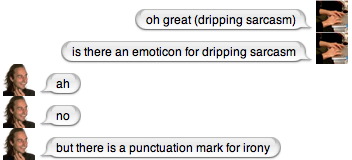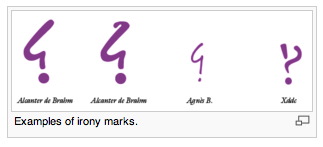The following exchange occurred this morning during a long IM session with a close friend and colleague:

Turns out there is an actual punctuation mark in French to indicate irony which you can read about in this wikipedia article.

I don’t actually use emoticons because i find them so aesthetically uninteresting, so i love the idea of a new class of punctuation marks evolving to take the place of the smiley face in all its saccharine implementations.
Author Archives: bob stein
try to take some time from your busy day
to read the recent interview with humanist and computer scientist, Alan Kay. Here’s a sample . . .
The things that are wrong with the Web today are due to this lack of curiosity in the computing profession. And it’s very characteristic of a pop culture. Pop culture lives in the present; it doesn’t really live in the future or want to know about great ideas from the past. I’m saying there’s a lot of useful knowledge and wisdom out there for anybody who is curious, and who takes the time to do something other than just executing on some current plan. Cicero said, “Who knows only his own generation remains always a child.” People who live in the present often wind up exploiting the present to an extent that it starts removing the possibility of having a future.
atomisation, part two
In the last few weeks a number of people have sent me a link to Michael Wesch’s video meditation on the evolution of media and its likely impact on all aspects of human interaction. One of Wesch’s main points is that the development of XML enables the separation of form from content which in turn is fueling the transition to new modes of communication.
Paradoxically Wesch’s video works precisely because of the integration of form and content . . . possibly one of the best uses of animated text and moving images in the service of a new kind of expository essay. If you simply read the text in an RSS reader it wouldn’t have anywhere near the impact it does. Although Wesch’s essay depends on the unity of form and content, he is certainly right about the increasing trend on the web to decontextualize content by making it independent of form. If Mcluhan was right about the medium being a crucial part of the message, then, if we are looking at content in different forms are we getting the same message? If not, what does this mean for social discourse going forward?
going, going, . . . .
David Streitfield wrote a smart piece on the demise of the independent bookstore in todays’ LA Times. It’s not particularly nostalgic, just an intelligent analysis of why bookstores are disappearing.
video (in your own words)
is the slogan of Mojiti, a company based in Beijing which has enabled commenting for video. Users can annotate any video on YouTube, Google, MySpace and about twenty other providers with text, shape and images. the annotations can be animated as well. The interface for making comments is unusually simple and straightforward. On first glance this is an important step forward in web 2.0 applications. [note: the demos all show text fields with solid backgrounds obscuring the video. in fact it’s quite easy to make the text box transparent or to turn off the annotations at any point to see the unalloyed video]
re-imagining the academic conference in the networked era
Last spring i gave a talk at the Getty Research Institute organized by Bill Tronzo, an art historian at UC San Diego. Bill told me about a conference he’s planning for 2008 on the subject of fame and said he was interested in exploring new ways of presenting the conference proceedings. i invited Bill to come to NY to discuss this with me, ben, dan, ray and jesse. In the course of the discussion we convinced Bill that it would be really interesting to re-think not just the form of the proceedings that get published after the conference, but the structure of the academic conference itself. For anyone whose been to a big academic meeting lately and sat through endless panels where anywhere from five to as many as ten people get a few minutes to read or summarize a paper it’s clear that the form is need of an overhaul. Academic conferences, just like academic presses, have been perverted and turned away from their original purpose — to encourage and enable intellectual discourse — in order to become key vehicles in the tenure/review process.
The connection between re-thinking conferences and re-thinking books goes much deeper. As regular readers of if:book know a lot of our work involves expanding the boundaries of “a book” to include the process that leads up to its creation and the conversation that it engenders. Why not try to expand the notion of a conference to include various aspects of pre-meeting effort and the conversation that goes on during the conference and afterwards. From one perspective, we’re not suggesting profoundly different action but rather attempting to capture a lot of what happens in a form that is likely to strengthen the impact of the effort.
We suggested to Bill that it would be interesting to co-sponsor a meeting of a small eclectic group to discuss how we might re-imagine a conference. Gail Feigenbaum and Tom Moritz, the two deputy directors of the GRI were enthusiastic and we held a one-day meeting last week with ten people. meeting planning blog and notes are here.
Following are some notes i wrote after the meeting:
. . . for me the most important outcome of the day was to loosen up long-standing preconceptions about conference formats; we’ve just touched the surface here and i hope we might find a way to continue the process and deepen our understanding of these issues in the coming months. following are a few thoughts i jotted down on the plane back to NY today. in rereading quickly i think i may have said the same thing six slightly different ways . . . . hopefully at least one will make sense.
is the principal purpose of a conference to provide an excuse/motivation for the writing of a paper or is it to enable face-to-face discussion about questions and themes within a particular discipline. i think it might be too easy to say that of course it’s both. i’m wondering which is primary.
the traditional conference which is structured around the presentation of papers might be putting the emphasis on the wrong aspect; focusing on the presentation of the author/speaker while leaving the discussion for the hallways, dinner tables and cocktail lounges. conferences officially capture the one thing which you don’t need a conference to capture – the written record of the formal paper. we can do better than this.
what would happen if we saw the principal purpose of a face-to-face conference getting people to look at discipline-specific problems in new ways; i.e. not mainly generating new knowledge in the form of papers, but encouraging a re-thinking and/or deeper analysis of the key issues in the field. from this perspective, the role/goal of the organizer is to ask good questions and create an environment for a vigorous discussion, sending people home with fresh perpectives for approaching their work.
what happens if the stars of a conference aren’t the writers of papers but rather brilliant discussion moderators who know how to lead engaging discussions? what happens if the important yield of a conference isn’t pre-prepared papers but a “record” of a complex discussion which deepens everyone’s understanding of the questions.
what happens if we see papers not as what happens “at conferences” but what happens between conferences?
what happens if we begin to see the most important aspect of knowledge, not the content of papers but the discussion about the ideas in a paper?
i’m quite sure that many of these questions i’m raising are too simplistic, but am hoping that they might help continue the process of trying to understand the essential purpose of academic discourse and the forms it might take.
apologies for relative silence
The beginning of the week was spent at the Educause conference in Atlanta where Jesse and I conducted the first public hands-on event with Sophie in which forty professors got to load it on their machines and put it through some not-terribly taxing paces. it was touch and go but Sophie performed well enough that people seem to be excited about getting a real beta version, hopefully next month. Yesterday, ben and i were at a small all-day meeting at the Getty Research Institute to discuss how a scholarly conference might be conceived differently in the era of the network — not just the “proceeding” that get published afterwards but the run-up to the meeting and the face-to-face portion as well. We brought along Trebor Scholz, Manan Ahmed and Michael Naimark, each of whom wowed me all day long with their remarkably prescient thoughts on the matter. Turns out that re-thinking conferences is remarkably similar to re-thinking books . . . the big questions all relate to re-defining long-standing rhythms and hierarchies which have been in place for a few hundred years — the role of the speaker and audience is being up-ended in ways similar to the roles of author and reader.
robinson crusoe
David Rothman over at Teleread has a very thoughtful review of a multimedia project coming out of the University of North Carolina which traces the real-world aspects of the Robinson Crusoe story. Rothman asks some very interesting questions about the possible over-use of Flash and the relationship of multimedia to text. (note: he says something very complimentary about me in the piece which makes me uncomfortable recommending it, but the questions he asks are important and very much worth considering.)
triangulating reality — the net at its best
Now that Hussein and Zarqawi are dead, the U.S. propoganda machine is working overtime to demonize Moqtada al-Sadr as the key obstacle to “peace in Iraq.” It’s fairly easy for them to do that since no mainstream U.S. news outlet bothers to interview him or present his ideas in any coherent fashion. Last week the Italian paper, La Repubblica published an interview with him that was not covered here. Helena Cobban (who was the first commenter in our edition of the Iraq Study Group Report), has just put up a translation on her blog. Read it to see a completely different view of the man than the one you get here. Read it to realize the power of the internet to get people working together to present a more complex view of reality than the one we get via the mainstream press. Here is Helena Cobban’s postscript to the post:
Update Saturday p.m.: Christiane just sent me a great document that’s a three-column tabulation of the Italian original, JHM’s translation, and her own. It’s a Word doc. She has picked out in red the few points where she feels JHM probably misunderstood the Italian, but says in an accompanying email that she thinks his English is far better than hers. Thanks, Christiane, and thanks again, JHM. You’re once again showing us the great information-leveraging power of the internet.
ambiguity — it’s not a bug, it’s a feature
the insititute is convened at a retreat on the jersey shore today and tomw. we’ve invited seven of our closest co-conspirators to discuss the future. the title of this post was the last thing that someone put up on the whiteboard. more later.
